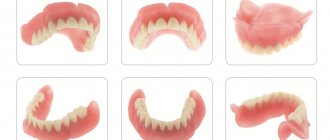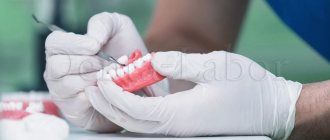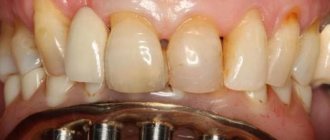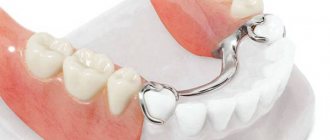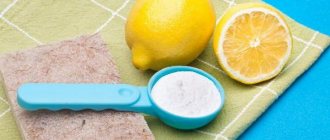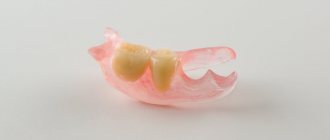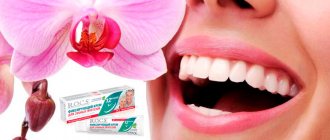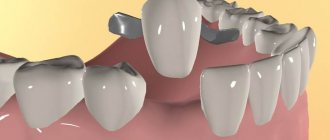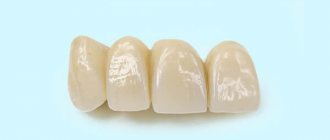Clasp prosthetics: types of fixation
Unlike a completely removable denture, which is tightly adhered to the jaw mucosa using a special adhesive composition, the fixation system for clasp dentures can be of several types:
- Clasp prosthesis. Fastening occurs through hooks made of metal alloys that cling to the neck of the abutment tooth. A clasp prosthesis for the upper (or lower) jaw does not require preparation of the tooth surface if there are no carious lesions and integrity is preserved.
- Clasp denture with locking fixation for the lower and upper jaw. It consists of two components of fixation: fastening to a ground abutment tooth and using locks.
- Telescopic clasp dentures. With this method, permanent metal crowns are first installed, which are later changed to a ceramic type.
Dental prosthesis: types of fixation
In addition to the nuances described above, it is of great importance whether the remains of the natural tooth are preserved. The types of dentures according to the type of fixation are as follows:
- permanent gluing. Perhaps, if the root and at least 40% of the neck and crown are completely preserved. Such products are fixed with glue, composite or cement. Techniques are used to install any microscopic prostheses, crowns and permanent bridges;
- pin mounting. It implies that the root is partially preserved, and the neck and crown are destroyed “to zero.” In this case, a metal rod is screwed into the root canal. A crown or bridge is subsequently attached to this pin. The good thing about this method is that it allows you to preserve a living root even in the last stages of its destruction;
- fixation on the implant. This means that the tooth was completely removed, and perhaps a long time ago. A metal screw is inserted into the deep layers of the bone. It is similar to a pin, but many times longer. The peculiarity of the technique is that the implant takes a long time to take root (six months or longer). Only after positive implantation results can the screw be placed into a permanent crown or bridge;
- temporary gluing or suction. It is used in two clinical situations. The first is for installing temporary prostheses while permanent ones are being prepared in the laboratory. The second is if the patient has refused any options for permanent prosthetics, and the teeth are completely destroyed. In this case, the prosthesis is attached with suction cups, plus the patient uses special glue every day.
In addition, a dental prosthesis can use auxiliary retainers:
- metal arcs;
- clasps (special hooks of various shapes);
- metal bolts;
- products with automatic latching (locks, buttons).
A variety of types of dentures allows you to solve any dental problem at a price acceptable to the patient.
What is a clasp denture with clasps?
It’s good when the patient learns what a clasp denture looks like only in old age. But statistics say that 14% of Russians experience complete adentia (loss of teeth) by the age of 30. Therefore, the sooner dental treatment and prosthetics begin, the longer the remaining teeth will last.
Removable dentures, which include clasp dentures, are a treatment method that is widely used in orthopedic dentistry. Their purpose is to restore the dentition on the upper and lower jaws. The term itself is German - bugel - and is translated as “arc”, that is, the literal concept of “bugel” - “having an arc”. The design consists of an arch cast from metal or plastic, with artificial teeth attached to a base that imitates gums and fixing elements in the form of hooks (clasps), clasps or crowns.
Clasp fixation of dentures is strong, durable and easy to maintain. Designs with clasps are also considered a reliable alternative to bridges and plate prostheses.
Important!
Conventional plastic prostheses are inconvenient due to the massive thick base through which the prosthesis is attached. The patient's palate is covered with thick plastic, which affects diction and taste buds.
Clasp dentures with a clasp fixation system are much more convenient in this regard. The palate is open, the risk of the structure falling out is minimal - a small base on the lower jaw gives freedom to the tongue, the adaptation period passes quickly. The dimensions of the base are reduced due to clasps, which are also responsible for the fixation function.
Cover structures – what are they?
In the classical sense, overdentures are removable appliances that get their name from the word “overdenture,” which literally means “overdenture” in English. That is, they usually cover, or more precisely, rest on the teeth and roots preserved in the mouth, or installed implants. In this case, the term “covering” is considered most appropriate.
Overdentures are removable appliances
However, today this is the name given to any removable systems. Even those that rest solely on the gums, when there are no teeth at all in the mouth. Experts justify this by the fact that in this case the structures are also covered, only not by implants and teeth, but by gums.
A dental overdenture can fill just one defect, can be partial (for partial and multiple edentia) or complete, when it is necessary to restore all the teeth on one/several jaws.
Now let’s look in more detail at what methods of fixing covering systems in the oral cavity exist.
Advantages and disadvantages of clasp-based dentures
Pros:
- Strength. A clasp prosthesis with a clasp fastening has a metal arch, which makes the structure stronger than plate prostheses.
- Long service life - up to 10 years.
- There is no need to grind the supporting teeth, as with bridge prosthetics.
- Adaptation occurs faster than with conventional plastic prostheses due to the thin and non-volume base.
- The design is used in splinting teeth with pathological mobility.
- Compared to implantation and ceramic bridges, the price of clasp dental prosthesis is significantly lower.
Minuses:
- The jaw atrophies over time - clasp dentures cannot stop the decrease in bone tissue. In this regard, it is better to choose implantological treatment for prosthetics.
- Lack of aesthetics. Fixing hook-clasps made of metal are noticeable when talking and smiling.
- The adaptation time takes from 7 to 14 days due to the base in the sky.
- Clasps put pressure on tooth enamel, which can be damaged by heavy chewing loads.
In order to avoid these disadvantages, some patients choose a clasp denture with locks .
Stock
-11%
Segment of chewing teeth with prosthesis on day 3 135,000 rub.
120,000 rub.
get -50 %
Manufacturing of removable denture Acry Free 40,000 rub.
20,000 rub.
get -40 %
Promotion for installation of veneers!
30000 rub. 18,000 rub.
get -62 %
Metal-free dental crown made of zirconium dioxide 25,000 rub.
9500 rub. get
Indications for clasp dentures
Indications for the installation of a partial denture depend on the number and integrity of the supporting teeth, the sensitivity of the soft tissues of the gum mucosa, the health of the periodontium and the shape of the alveolar processes.
- Unilateral or bilateral terminal defect of the dentition.
- Impossibility of prosthetics with fixed structures.
- Tooth mobility associated with periodontal disease.
- Missing one tooth.
- Prosthetics of anterior teeth.
- Pathological abrasion of teeth.
Fixing cream
Adhesive (fixing) preparations are available in the form of creams, powders or fiber pads. The most popular among them are creams that are produced on the basis of water-soluble polymer materials. They are easy to use, have additional antiseptic and aromatic properties and allow the patient to completely eliminate defects in the prosthetic device at the same time as more durable fixation. Manufacturers additionally add anti-inflammatory oils to some creams, which have a beneficial effect on the condition of the gums.
The principle of using a fixing cream is quite simple: immediately before applying the cream, you need to thoroughly rinse the prosthetic device and brush your teeth. Then a small amount of fixing cream is applied to the inside of the denture base. The device is placed on the teeth and pressed lightly for five to seven minutes. The adhesive preparation is completely compatible with biological tissues of the oral cavity, its composition is natural and does not cause allergies.
An essential feature that all patients need to be aware of is the condition of healthy gums. Any acute or chronic inflammation of the soft tissues of the oral cavity requires the owner of the prosthesis to temporarily refrain from using the orthodontic device and its fixing agents.
Contraindications for installing removable dentures on hooks
Removable structures have virtually no contraindications, but in some cases, prosthetics for the lower/upper jaw is not possible:
- Pathology of the periapical tissues of the supporting teeth, low supporting teeth or their absence.
- Intolerance to removable dental structures.
- Diabetes.
Temporary contraindications:
- Acute oral diseases.
- Pregnancy.
- Radiation therapy.
- Lack of quality and regular oral hygiene.
- Diseases of the bone tissue of the jaw.
- Mental illnesses.
Method No. 3: fixation of removable covering systems on implants
Removable overdenture on implants - what is it? This is when, instead of gums or roots of living teeth, artificial metal roots (made of titanium) act as support for the structure, which are implanted into the bone tissue of the jaw.
In this case, implants help improve the quality of fixation of removable devices, which makes the process of their use more comfortable. This option is a kind of intermediate link between completely removable systems (we talked about them earlier) and completely non-removable ones (be sure to read about them further).
If a patient wants to improve the stability of removable overdentures, doctors first install artificial roots into the bone tissue. That is, implants. The minimum is 2-4 pieces (the more, the more reliable, of course). Sometimes mini-implants are used as this option. But this method can only be considered on a temporary basis - such structures cannot withstand the load.
How dentures are attached to implants in this version will be discussed below.
On ball-shaped abutments
Abutments, which are placed on top of the implants, are connected to each other and combine the implant and prosthesis into a single system. In this case, spherical abutments are used for fixation, resembling a ball in appearance. Corresponding holes are created for them in the recess of the prosthesis.
This is what a prosthesis on ball-shaped abutments looks like
This is the most affordable option in terms of finance, but not the most comfortable. The internal fastening elements inside the prosthesis wear out, stretch and break, so they periodically need to be replaced with new ones.
In addition, the system does not distribute the chewing load well. This fastening is used both when installing full-fledged implants and mini-models. In the latter case, the abutments form a single whole with the body of the implant (one-piece structures).
Experienced doctors advise considering this method of attachment only as a temporary measure, especially when choosing mini-implants. It is suitable for those patients who want to increase the stability of removable structures in the oral cavity. But you shouldn’t count on the fact that with such devices you will eat without restrictions.
On Locator type equatorial abutments
If the covering dental prosthesis is fixed on equatorial abutments, then this is much better than when it is fixed on spherical fastening elements. The Locator system is distinguished by a solid cylindrical shape, which contributes to a more even distribution of the chewing load, prevents rapid breakage of the abutments, and increases the level of comfort.
The Locator system features a solid cylindrical shape
On a strong metal beam
Implants in the amount of 2-4 pieces are implanted into the jawbone, and a metal beam is installed on top, connecting them to each other. Next, a removable structure is snapped onto the beam, the base of which has special holes. If necessary, the patient can detach and attach the denture, but the bar will always remain in the mouth.
This option is more comfortable and durable than those listed earlier. But its cost is quite high, which is why modern patients prefer to choose more advanced methods of dental restoration, which today are almost equal in price. Namely, fixed prosthetics also supported by implants.
The prosthesis can be fixed on a metal beam
It is interesting that fixed dentures also have a beam fastening system. But, unlike removable ones, such a beam is more reliable, is created individually and remains inside the prosthesis, that is, it forms a single whole with it. Such a system is, of course, more reliable.
Manufacturing and installation of clasp prosthesis on clasps
Orthopedic design is divided into the following types:
- Soldered.
- Solid cast.
- Phrased.
- Fabrication of a frame using laser sintering of nanoparticles of a special powdered metal alloy.
Attention!
In practice, the Astra Clinic prefers to use the last two manufacturing methods. This progressive type allows you to make the most natural and high-quality clasp.
Installation of a clasp prosthesis is divided into several main stages:
- Examination and x-ray examination of the jaw. The laboratory stages of making a clasp prosthesis begin after examining the patient. The attending physician evaluates the relationship of the dentition to ensure there is enough space for the base. If necessary, the abutment teeth are ground down to provide space for occlusal pads.
- If no contraindications are identified, an alginate impression of the upper and lower jaw is made for a diagnostic model of the prosthesis. The dentist monitors the clarity of the elements of the prosthetic bed and the absence of pores - the quality of the prosthesis depends on the quality of the impression.
- Making a plaster model of a clasp prosthesis with clasp fixation based on the impression obtained. A drawing of the frame of the future structure is also being developed.
- Casting of the frame base, followed by grinding and polishing.
- Trying on clasp dentures on the jaw. If necessary, correction is carried out.
- Installation of clasp dentures.
The frame of the clasp prosthesis is cast from cobalt, chromium and molybdenum or from a gold-containing alloy. Thanks to the large amount of chromium in the composition (more than 25%), the frame is resistant to corrosion and has high biocompatibility. Allergic reactions to such an alloy practically do not occur.
Types of clasp
Removable dentures with clasps, depending on the purpose of prosthetics, can be equipped with the following types of hooks:
- Retaining. When loaded, the clasp for fixing dentures settles and thus transfers pressure to the mucous membrane of the jaw.
- Supporting. The pressure that appears during talking or chewing is transmitted both to the supporting teeth and to the mucous membrane of the jaw.
- Support-retaining.
The clasp system of a clasp prosthesis can vary in shape and method of coverage:
- Flat, round, semicircular and ribbon clasps.
- Hooks with one, two arms, single-link, double, in the form of a ring.
The production of clasps for clasp dentures is also divided into two methods:
- Casting (the clasp has no springing properties).
- Bent (made from special blanks).
Method No. 2: on the patient’s natural teeth
A modern overdenture can be more securely fixed in the mouth if there are supporting teeth or preserved roots. This fastening option is possible to improve the fixation of removable appliances even if there are extensive defects1 in the dentition, and when only a few elements have been preserved that can become supporting ones. There are several mounting options available here.
A tooth-retained overdenture is also removable, but it is lighter and more compact than a design that is retained solely on the gums. It has a reduced palatal overlap, and sometimes there is no such overlap at all (for example, in sandwich dentures), which allows the patient to feel the taste of the food consumed. However, such devices contribute to rapid wear and destruction of the supporting elements of the row, because during operation they bear a serious load.
On clasps
Such overdentures are attached to the mouth using special hooks that tightly grip the supporting elements of the row. This is one of the most financially accessible, but not always convenient and aesthetic varieties. After all, hooks can be noticeable in the smile area. In addition, clasps can become loose and fail, which ultimately leads to instability of the entire system, displacement of the devices, and physical and psychological discomfort.
The photo shows a prosthesis with clasps
“I had to remove a couple of teeth. After that, for several weeks I agonized over the best way to restore them - with bridges or implants. I can’t decide on either one or the other... And money is still tight. And so my doctor advised me to temporarily install the covering apparatus on hooks, saying that it was inexpensive and there was no need to sharpen my teeth for it. I agreed on the condition that while I was wearing it, I would calmly make a choice and save money for a normal treatment option.”
LenaElena, review from 32top.ru
On attachments or clasps
One part of the fastening is installed in the abutment tooth or root, and the second is installed in the base of the removable product - the two elements are simply combined and snapped into place. This method of fixation significantly increases the stability of the structure and also improves its performance characteristics. The overdenture with clasps is compact and lightweight. The patient no longer has to take it out of his mouth every day. However, the price for it is much higher than for a product with hooks.
This is what a prosthesis with clasps looks like
Teeth cannot be used as support if they are severely damaged or inflamed, have cysts and granulomas on the roots, or are loose due to periodontitis and periodontal disease. They must first be cured, if, of course, they are treatable. In the latter case, that is, with periodontal diseases, the doctor can offer the patient a special splinting structure (clasp devices) with hooks that tightly grasp each loose element of the row.
Using telescopic crowns
When doctors offer patients overdentures attached to telescopic crowns, not everyone understands what it is. The design of such devices provides for the presence of several hollow crowns that are fixed to the supporting elements of a row, previously covered, again, with artificial crowns.
The photo shows a prosthesis on telescopic crowns
The connection of all components of the system into a single whole occurs according to the telescopic principle, when one crown is made slightly smaller in diameter than the other. As a result, the two fastening elements fit tightly onto each other, which ensures high quality fixation. The price of such products is quite high, because their production involves painstaking work and a high level of professionalism of the doctors who perform it.
Caring for clasp dentures
Despite the fact that artificial teeth are not susceptible to caries, care for structures with clasps should be regular and daily. It is best to clean your mouth after every meal; brushing in the morning and evening is mandatory.
Basic rules of care:
- Clean the clasp denture with toothpaste and a brush. Take your time and carefully remove plaque and dirt.
- Rinse your mouth after eating with water or a special mouthwash that contains various additives with an antibacterial effect.
- Clean the structure at least once a day with products specially designed for dentures. There are also disinfectant tablets that dissolve contaminants and provide a thorough clean.
- Do not use abrasives to avoid damaging the surface of the product.
- Once a year, give your dentures with clasp fixation for special cleaning. Perhaps, at the same time, restoration of the structure will be required, which is done only in laboratory conditions. The technician will adjust the arc angle, check for cracks and tightness, and correct defects. The cost is not high, but the procedure may require several days to complete.
You should not remove the clasp dental prosthesis in the first two weeks after installation - this is the time of adaptation to the structures. After getting used to them, they need to be removed twice a day (after rinsing your mouth with water) in order to thoroughly clean the oral cavity and the denture itself.
Comments
What materials are such a prosthesis made of?
Makarova O.A. (08/21/2020 at 10:17 pm) Reply to comment
- The artificial base and gingival edge of the prosthesis are usually made of acrylic, but they are also made of nylon, silicone, polyurethane, and non-monomer acrylic resins. Fastening elements can be made from the base material that makes up the base of the prosthesis, but for strength and greater wear resistance they are often made from medical metal alloys. As for artificial teeth, they are made of plastic, metal-plastic, ceramic and metal-ceramic, and zirconium dioxide. That is, the choice is very wide and actually depends primarily on the type of prosthesis you choose (removable or implant-supported).
Editorial staff of the portal UltraSmile.ru (08/23/2020 at 12:21 pm) Reply to comment
Thanks for such a wonderful article. Tell me, what do you think, with very problematic and regularly inflamed gums, which option should you pay attention to first? The area for prosthetics is large, but I don’t want removable dentures.
Marina A. (09.23.2020 at 09:18) Reply to comment
Please tell me, my mother wants to install such a prosthesis, but I have heard that they are not reliable, they can fly out and wobble. In this case, there will be severe discomfort, is that true?
Elena (09/23/2020 at 01:01 pm) Reply to comment
And I heard that fixing dentures with cream, firstly, is not very reliable, and secondly, with prolonged use it can be dangerous. What creams should I use to ensure safety?
Victor (09/23/2020 at 01:07 pm) Reply to comment
If a removable denture was installed not so long ago, you are wondering how it is fixed, what is the covering structure? How much will it cost to fix removable covering systems on implants?
Oleg (09.23.2020 at 14:30) Reply to comment
Dentures were placed on the upper jaw. It took me a long time to get used to it, they pressed and rubbed. The gums were inflamed. I went many times for correction. Probably in a couple of months I began to wear them fully, but they began to fall off while eating. My dentist recommended Mostaden Twins Tech cream to me. It easily attaches to wet dentures. Does not change the taste of food and drinks. There is a pleasant mint taste in the mouth. Has a secure hold for up to 12 hours. Prevents food from penetrating under the denture. I began to fully wear the prosthesis without fear that it would fall out while eating or while talking.
Alice (10/21/2020 at 11:34 am) Reply to comment
Good afternoon Can you please tell me how long it will take to install dentures on my natural teeth? Is there any alternative while the prosthesis is being manufactured? Thanks in advance for your answer.
Sasha (11/20/2020 at 6:29 pm) Reply to comment
Of course, you can fix any prosthesis in your mouth. Both the lower and upper parts. But if you had surgery or had a bone cut off, then the prosthesis may not fit on such gums. Not every specialist will undertake such work.
Alina (11/20/2020 at 08:22 pm) Reply to comment
It’s good that now there are so many ways and options. But which one is the most reliable, which is recommended in most cases? Or will it all be purely individual?
Olga (11/20/2020 at 08:29 pm) Reply to comment
After reading the article, several questions arose. 1) How long do removable and fixed implants last? Which ones are more durable? 2) Is it difficult to care for them and maintain an aesthetic appearance?
Artyom (11/20/2020 at 09:04 pm) Reply to comment
Of course, implants are better because they will last better. And so my mother used Corega cream. Helped a little, but not much. She has the most ordinary prosthetics. Although I already made the second one 15 years later. The gums sank, so the first ones no longer held up.
Peter (11/20/2020 at 9:16 pm) Reply to comment
